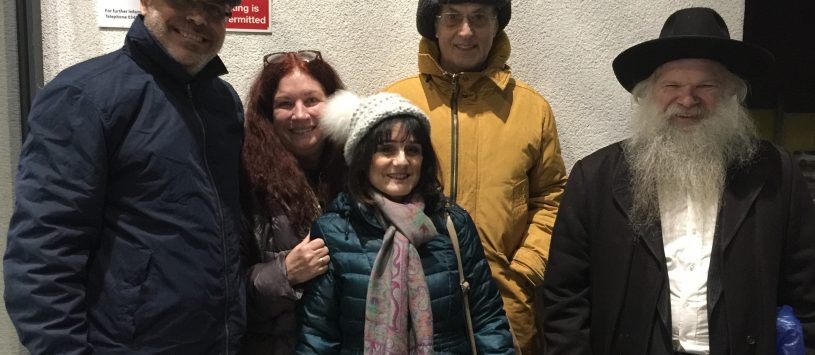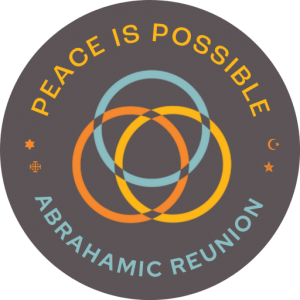
Today we will be going to Spring Hill Prison to offer a workshop about light.
It is 3:30 in the afternoon and it is already dark as Ghassan and I travel by underground to Marylebone Train station to meet the Abrahamic Reunion’s UK Directors, Michael and Amanda Kenton and Rabbi Herschel Gluck OBE
Rabbi Herschel Gluck, OBE is a perfect partner for us. He is the founder and chairman of the Arab-Jewish Forum and is also the elected president of “Shomrim” in Stamford Hill, where he lives.
Stamford Hill is an area of London known for having the largest concentration of Charedi Hasidic Jews in Europe. Once a small Charedi enclave, the Jewish population of Stamford Hill grew during and after World War II as refugees fled Nazi Germany, and Holocaust survivors sought refuge in Britain. It is a small area no bigger than two square miles that contains more than 50 synagogues, dozens of orthodox schools and numerous kosher supermarkets, butchers and bakers.
It is also an area where a large number of anti-Semitic attacks take place. In response to these attacks, the community founded Shomrim, (Hebrew for “guardians” or “custodians”), a neighborhood watch group that patrols the streets of north-east London to clamp down on crime and protect the Jewish population of Stamford Hill.
 The Queen appointed Rabbi Gluck “Officer of the Order of the British Empire” (OBE) for his significant role as an international mediator in conflicts as diverse as those in the Sudan and the former Yugoslavia.
The Queen appointed Rabbi Gluck “Officer of the Order of the British Empire” (OBE) for his significant role as an international mediator in conflicts as diverse as those in the Sudan and the former Yugoslavia.
Most of the men in Spring Hill prison have never met a rabbi before and each time they interact with Rabbi Gluck they are impressed with his humor and his wisdom.
Spring Hill prison’s primary purpose is to prepare long-term prisoners for release by offering programs to help them adjust to life outside of the prison system.
Tonight we meet Ahmed for the fourth time. Ahmed has helped organize this event for the men.
We also meet another man who has helped Ahmed organize this event. He says he has spent his years in prison becoming a certified yoga instructor, and he teaches daily yoga sessions in the prison for both the inmates and the staff.
He hopes to support himself as a yoga instructor when he is eligible to leave prison. In the meantime he spends hours every day immersing himself in Yogic techniques such as yoga postures (asanas), breathing practices (pranayamas), and meditation in order to attain the highest level of consciousness.
 He says he is excited about the program that Ghassan has prepared for tonight because we are going to be talking about light from the perspective of different faith traditions. I am humbled when he says he does light meditations every day.
He says he is excited about the program that Ghassan has prepared for tonight because we are going to be talking about light from the perspective of different faith traditions. I am humbled when he says he does light meditations every day.
As the men gather around us I try to imagine what it must be like to transition from life inside of a prison to life outside.
The young man next to me was 18 years old and had just finished high school when he entered prison in 2001. He is almost the same age as my daughter. Since 2001 my daughter has graduated college, obtained a driver’s license, driven a car, bought a car, learned how to use a credit card, opened a bank account, bought a cell phone and learned how to text. She has opened her own email account and used it looked for a job online, found a job, rented an apartment, fallen in love, married, had children, received a mortgage and bought a house. She has bought an airline ticket, gone through a TSA check points, flown in an airplane, picked out her own clothes, shopped online, watched Netflix, shopped in a store, eaten in a restaurant, bought groceries and cooked food for herself and for her family.
The young man next to me hasn’t done any of those things.
When we ask him how it’s going, he tells us that he has received his first debit card only a few days ago, and says that he is learning how to use it. He says he will be eligible to start a part time job soon. He starts trembling and admits, “I am so terrified. I have been outside now, and the world has changed so much. I don’t even recognize anything…. the way people dress…. their hair….’’
His voice trails off. I find myself holding my breath as I listen and absorb the overwhelming level of anxiety that I sense he must feel.
But then he begins to describe his parents and how they are preparing to help him. I say a silent prayer for the other men sitting around us who may not have supportive parents or family to turn to when they will be getting out.
Ghassan has us all sit in a circle and introduce ourselves. It is a diverse, multi-racial and multi-ethnic group. The men come from family backgrounds in Albania, Ireland, England, Bangladesh, Pakistan, and the Caribbean.
 Ghassan says tonight we will be talking about light. He talks about Christmas, and says that Muslims will also be celebrating the birth of Mohammed in December this year. Then he asks Rabbi Gluck to explain Hanukkah to the group.
Ghassan says tonight we will be talking about light. He talks about Christmas, and says that Muslims will also be celebrating the birth of Mohammed in December this year. Then he asks Rabbi Gluck to explain Hanukkah to the group.
Rabbi Gluck offers a fascinating allegorical explanation about the symbolism behind lighting the candles of Hanukkah sequentially.
He explains that when we are in a “dark place” it is important to take action and light even just one inner light to begin the process of “enlightenment”. He explains that the first action may be small, such as thinking a good thought, or performing a kind act, but he assures us that the effect of that one small act will multiply.
To remind themselves of the importance of taking action to dispel darkness, Jewish practitioners light one candle on the first night of Hanukkah. Then Rabbi Gluck describes how on the second night of Hanukkah Jews light a second candle to remind themselves that the effects of their original good action will grow and transfer to another.
He explains how on each new night of Hanukkah, Jews light an additional candle to demonstrate how their good thoughts and good deeds will grow within them and pass to others, until their effects will extend out to the whole world.
As we contemplate Rabbi Gluck’s vivid description of lighting the Hanukkah candles, we each experience ourselves being lit with the growing light of inner illumination.
I can almost feel the yogi next to me imagining Hanukkah as a type of meditation.
 Then Ghassan passes out copies of religious scriptures about light and asks participants to volunteer to read out loud. We are stunned by the beautiful way each faith tradition reminds its practitioners about the significance of light.
Then Ghassan passes out copies of religious scriptures about light and asks participants to volunteer to read out loud. We are stunned by the beautiful way each faith tradition reminds its practitioners about the significance of light.Ghassan has us break into small groups of five people and tells us to spend a half an hour discussing the nature of light and darkness and the scriptures we have just read together.
As we sit in our small groups and share, it is as though we are on a journey, traveling together through various landscapes of light. We experience the light between us, and begin to smile and relax with one another.
Members of our group begin to describe to one another the nature of light and darkness, and point out to one another the ways that the words “light” and “dark” are used in everyday conversation.
We talk about using phrases like “bright idea” and “lighten up” and contrast these with phases such as “feeling gloomy” or describing someone as “shady”. We speak about “the dark night of the soul”
As we talk about the “dark night of the soul”, the yogi, who is in our group, confides in us and speaks about what he felt like years ago on his first night in prison. He describes the darkest and scariest night of his life. Others in our group nod in recognition. Then he describes how from that state of utter inner blackness, somehow he found a flicker of light that led him to totally transform himself and find his life’s path as a yogi. Others in the group begin to describe how, when they had totally lost their way, some inner light led them toward a path of goodness.
In our final round of sharing, we finally explore together, “What is light?” and “What is it actually?” And we find that each of us is able to touch on what we sense is the mystical essence of light, and that somehow we each manage to describe that essence to one another. It is an experience that fills us with joy and love for one another.
 When Ghassan calls us to rejoin the larger group, we look around and realize that each person has reached that same state. Love is radiating from the face of each person. As we sit grinning at one another, a representative from each small group shares with the larger group what happened in their discussions.
When Ghassan calls us to rejoin the larger group, we look around and realize that each person has reached that same state. Love is radiating from the face of each person. As we sit grinning at one another, a representative from each small group shares with the larger group what happened in their discussions.
We realize that although each group’s journey of sharing began in a different way, somehow we had all arrived at the same destination, in love with one another.
When people hand in their feedback forms, unanimously they rate their experience above the highest grade, and state that they would have wished the discussion to last longer.
Below is the beginning of a small note that Ghassan received from Ahmed the next morning:
“Salaam Ya Shaiykh,
It was an honor to have met you yesterday. As always it was a wonderful and uplifting experience. I particularly liked the way everything was organized with excellent discussions throughout the whole session. Can’t wait for next time….”
– Ahmed
 Rev. Cherag Anna Less, PhD Rev. Cherag Anna Less, PhDCo-Founder & Executive Director anna@abrahamicreunion.org |

